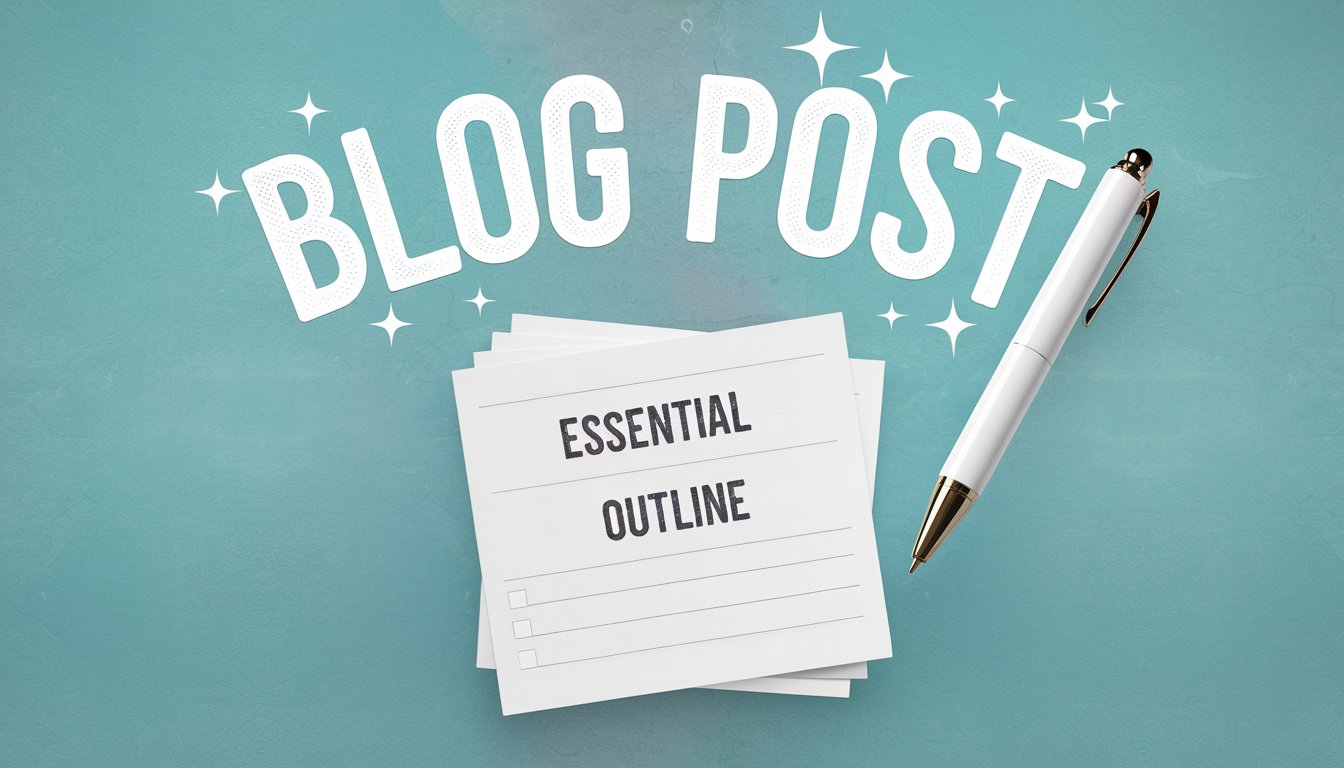Essential Blog Post Outline: Create Engaging Content Effortlessly
Making a blog post outline is a big deal for writers. It’s a key tool for organizing ideas and making the writing process smoother. With 73% of readers scanning blog posts, a good outline is essential for breaking down big topics into easy-to-digest parts.
A well-made blog post outline acts as a guide. It helps you stay on track and avoid writing that’s all over the place. Knowing your blog’s purpose and who you’re writing for helps you pick the best format to grab and keep readers’ interest.
Your outline is the base for content that grabs and keeps readers. It lets you add SEO tips, use the right keywords, and make sure your info flows well. Spending time on a detailed outline means your blog posts will not only rank well but also offer real value to your audience.
Understanding the Importance of a Blog Post Outline
A well-crafted blog post outline is key to good writing. It organizes your thoughts, makes reading easier, and keeps readers interested. For writers stuck, an outline acts as a clear guide, helping to break through creative blocks.
Using outlines saves time and meets client needs. Bloggers can create engaging content by following a structured plan. A good outline has a title, subheads, details, data, and a conclusion.
Outlines also help with SEO by organizing content well. This makes it easier for search engines to find and rank your articles. Adding personal stories to your outline can make your content more believable.
Starting with a solid outline ensures your content is complete and meets your goals. Whether you’re writing a review or a how-to guide, a good outline is essential. Remember, well-written blog posts can lead to more leads and sales, making outlining a smart investment.
Key Components of an Effective Outline
Creating a solid blog post outline is key to making engaging content. Start by brainstorming topics that your audience will find interesting. This step is the base for your content’s structure and flow.
A catchy headline is the first thing to focus on. It should clearly show what your post is about and include your main keyword. Then, write an introduction that grabs the reader’s attention. It should highlight a problem or ask a thought-provoking question.
The main part of your outline should have important points backed by evidence or expert opinions. Use subheadings to make these points easy to scan. This makes your content easier to read and helps search engines understand it better.
End your outline with a strong conclusion that summarizes the main points. Include a clear call-to-action. This structure makes your blog post valuable to readers and helps with SEO. A well-made outline can also lead to more time spent on your page and fewer people leaving quickly.
How to Choose the Right Blog Topic
Choosing the right blog topic is key to making engaging content. Start by looking at current trends and using tools like Ahrefs’ Keywords Explorer. This tool shows you topics that your audience might like. It also helps find subtopics that top pages in your niche cover.
Understanding your audience is also important. Check out Google’s People Also Ask boxes or use AlsoAsked to find popular questions. This way, you know what your readers want, making sure your content is relevant and interesting to them.
When you do keyword research, pick terms that fit your business goals. Look for topics that draw in visitors and could turn them into customers. Use tools like Semrush to see how competitive your chosen keywords are.
Make sure you can offer something valuable on the topic you choose. Go for subjects where you can share unique insights or detailed information. This way, your content will stand out and really help your audience.
Structuring Your Outline for Clarity
Creating a clear outline is crucial for writing engaging blog posts. Start by deciding between linear and non-linear formats. Linear formats are great for step-by-step guides. Non-linear structures work well for topics with many connections.
Use bullet points and numbers to break down complex ideas. This makes your content easier to read and understand. Adding visual content like infographics or videos can also help. It makes your blog more interesting and informative.
Look at top-ranking competitors to find effective content formats. This helps you pick a structure that shows your expertise. You might use listicles for quick tips, how-to guides for practical advice, or in-depth tutorials for complex topics.
Your outline should have 5 to 10 main points with 2 to 5 sub-points each. This ensures you cover your topic well without overwhelming readers. By following these tips, you’ll make clear, engaging content that your audience will love.
Crafting Compelling Introductions

Your blog introduction is your chance to grab readers’ attention. With over 600 million active blogs, standing out is crucial. Users spend an average of 52 seconds skimming a post, so your opening must be captivating. A strong content hook can make all the difference in reader engagement.
Start with a surprise or controversial statement to pique interest. Use short sentences of 5 to 6 words for easy readability. Incorporate statistics to build credibility and trust. For example, 75% of bloggers report that creating outlines improves content clarity.
Personal stories can forge connections with readers. Share a brief anecdote related to your topic. This approach makes your content more relatable and increases reader engagement. Aim for an introduction length of 100 to 200 words to maintain interest without overwhelming.
Address common pain points or pose thought-provoking questions. This shows you understand your readers’ concerns and sets the stage for valuable information. Use value listing to highlight benefits readers can expect from your post. Remember, your blog introduction should create anticipation and entice readers to explore further.
Developing Your Main Content
Creating a solid structure is key to content development. Use subheadings to break down main points. This makes your blog post easy to scan.
A well-structured outline boosts writing efficiency. Professional writers who produce over 9,000 words agree. They use templates to stay organized.
Adding evidence to support your main points adds depth and credibility. Use facts, statistics, or expert opinions. For example, did you know 43.2% of all websites use WordPress?
Keep a consistent tone throughout your post. This ensures coherence and keeps readers engaged. Answer questions that arise around your main points. Tie each point back to your common theme for a unified message.
With these strategies, you’ll create compelling content. It will resonate with your audience. This can increase your readership and income.
The Power of Storytelling in Blogs
Storytelling makes blog posts come alive. Personal stories connect with readers, making your content feel real. A good story keeps people interested from the beginning to the end.
Good storytelling has three parts: opening, explaining, and closing. The opening grabs your attention, the explaining part clarifies, and the closing leaves a lasting impression. This can boost your blog traffic by 50% quickly.
Using vivid descriptions and relatable characters makes your content stick in people’s minds. Share your own stories to add a personal touch. Remember, just 150 words of engaging storytelling can change your writing. By mastering these skills, your blog will stand out.
Incorporating SEO Best Practices

SEO optimization is key to making your blog more visible. Start by focusing on where you place keywords in your content. Use long-tail keywords in your posts to target specific search queries. This approach helps you rank better and attract the right audience.
Don’t overlook meta tags. Create compelling meta descriptions that include your target keyword and summarize your content well. Keep title tags between 50-60 characters to ensure they show fully in search results. These elements help search engines understand your content and can boost click-through rates.
Structure your blog posts with SEO-friendly elements. Use headers, bulleted lists, and numbered lists to make your content easier to read. This improves user experience and can help your search engine rankings. Also, place important content above the fold to engage visitors quickly.
Lastly, prioritize mobile optimization. With over half of internet traffic coming from mobile devices, a responsive design is essential. Users are 52% less likely to engage with non-mobile-friendly sites. By following these SEO best practices, you’ll increase your chances of ranking higher and attracting more readers to your blog.
Concluding Your Blog Effectively
Wrapping up your blog post is key to making a lasting impression. A strong conclusion recaps the main points and motivates readers to act. Start by summarizing the key ideas you’ve covered. This helps your audience remember and understand your message better.
Then, create a compelling call to action. This step encourages readers to engage and tells them what to do next. You could ask them to subscribe, check out more articles, or leave a comment. Use direct language like “Sign up now” or “Share your thoughts below.”
Also, spark a conversation. Ask questions or invite readers to share their experiences. This builds a community and keeps readers interested. Remember, a good conclusion turns readers into active participants.
By following these tips, you’ll make blog conclusions that connect with your audience. Your readers will feel informed, inspired, and ready to move forward with your content.
Editing and Polishing Your Blog Post
Blog editing is key to creating top-notch content. Begin by checking your post for grammar and spelling mistakes. This is crucial for keeping your readers’ trust.
Then, work on making your content easy to read. Break long paragraphs into shorter ones. This makes your blog more engaging.
Use online editing tools to make your work easier. They can spot areas for improvement and check for plagiarism. Planning ahead can also save you time during editing.
Make sure your tone fits your topic and audience. Use simple, clear language to get your point across. Pay attention to layout, word choice, and capitalization. By mastering these editing skills, you’ll find your own style and create content that grabs your readers’ attention.
Promoting Your Blog Content

Getting your blog noticed is all about content promotion. Start with a solid social media marketing plan. Share your posts on Facebook, Twitter, and LinkedIn. Use eye-catching visuals to grab attention and drive clicks.
Remember to tailor your approach for each platform. This will help you maximize engagement.
Email list building is also key for blog promotion. Encourage readers to subscribe to your newsletter. Offer exclusive content or early access to new posts as incentives.
Send regular updates to keep your audience engaged. This will drive traffic back to your blog.
Collaboration can expand your reach. Team up with other bloggers in your niche for guest posting or joint projects. This exposes your content to new audiences and builds valuable relationships.
For key pieces, consider paid promotion or partnering with influencers. This will boost visibility.
Remember, successful content promotion takes time and effort. Track your results, adjust your strategies, and keep creating valuable content. With persistence, you’ll see your blog audience grow and engagement increase.
Measuring the Success of Your Blog Posts
Tracking your blog posts’ impact is key to improving your content strategy. Blog analytics give you insights into what your audience likes and does. Start by looking at page views, time on page, and bounce rates.
These numbers show you which topics your readers enjoy and where you can do better. Performance tracking is more than just numbers. Look at comments, social shares, and click-through rates on calls-to-action.
These details show how well your content connects with your audience and prompts action. Remember, longer headlines (14 words or more) can double traffic and shares, SEMrush found.
Use tools like Google Analytics to get detailed data on your blog posts. Regularly check these insights to spot trends and make changes. For example, posts with bracketed clarifications in headlines can boost click-through rates by up to 38%.
By constantly improving your content based on these insights, you’ll make more impactful blog posts. These will rank higher in search results and better engage your target audience.





